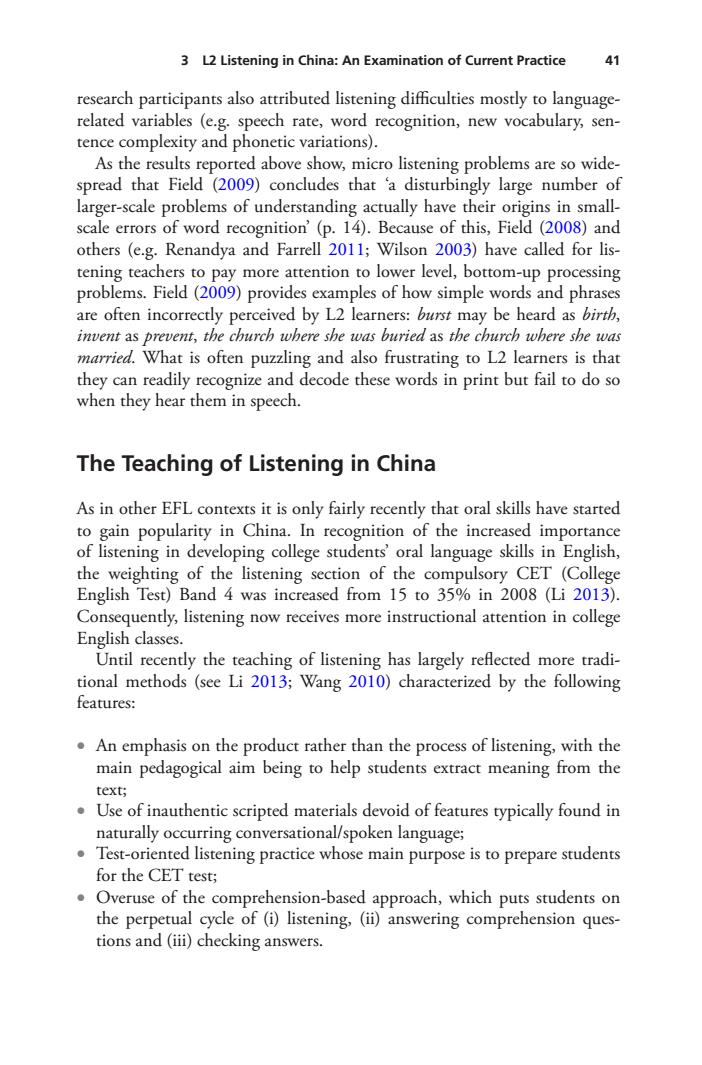正在加载图片...

3 L2 Listening in China:An Examination of Current Practice 41 research participants also attributed listening difficulties mostly to language- related variables (e.g.speech rate,word recognition,new vocabulary,sen- tence complexity and phonetic variations). As the results reported above show,micro listening problems are so wide- spread that Field (2009)concludes that 'a disturbingly large number of larger-scale problems of understanding actually have their origins in small scale errors of word recognition'(p.14).Because of this,Field (2008)and others (e.g.Renandya and Farrell 2011;Wilson 2003)have called for lis- tening teachers to pay more attention to lower level,bottom-up processing problems.Field(2009)provides examples of how simple words and phrases are ofen perceived by L:may be heard as invent as prevent,the church where she was buried as the church where she was married.What is often puzzling and also frustrating to L2 learners is that they can readily recognize and decode these words in print but fail to do so when they hear them in speech. The Teaching of Listening in China As in other EFL contexts it is only fairly recently that oral skills have started the weighting of the listening section of the compulsory CET (College English Test)Band 4 was increased from 15 to 35%in 2008 (Li 2013) Consequently,listening now receives more instructional attention in college English classes. Until recently the teaching of listening has largely reflected more tradi- tional methods (see Li 2013;Wang 2010)characterized by the following features: An emphasis on the product rather than the process of listening,with the main pedagogical aim being to help students extract meaning from the text: .Use of inauthentic scripted materials devoid of features typically found in naturally occurring conversational/spoken language; Test-oriented listening practice whose main purpose is to prepare students for the CET test; Overuse of the comprehension-based approach,which puts students on the perpetual cycle of (i)listening,(ii)answering comprehension ques- tions and (iii)checking answers. 3 L2 Listening in China: An Examination of Current Practice 41 research participants also attributed listening difculties mostly to languagerelated variables (e.g. speech rate, word recognition, new vocabulary, sentence complexity and phonetic variations). As the results reported above show, micro listening problems are so widespread that Field (2009) concludes that ‘a disturbingly large number of larger-scale problems of understanding actually have their origins in smallscale errors of word recognition’ (p. 14). Because of this, Field (2008) and others (e.g. Renandya and Farrell 2011; Wilson 2003) have called for listening teachers to pay more attention to lower level, bottom-up processing problems. Field (2009) provides examples of how simple words and phrases are often incorrectly perceived by L2 learners: burst may be heard as birth, invent as prevent, the church where she was buried as the church where she was married. What is often puzzling and also frustrating to L2 learners is that they can readily recognize and decode these words in print but fail to do so when they hear them in speech. The Teaching of Listening in China As in other EFL contexts it is only fairly recently that oral skills have started to gain popularity in China. In recognition of the increased importance of listening in developing college students’ oral language skills in English, the weighting of the listening section of the compulsory CET (College English Test) Band 4 was increased from 15 to 35% in 2008 (Li 2013). Consequently, listening now receives more instructional attention in college English classes. Until recently the teaching of listening has largely refected more traditional methods (see Li 2013; Wang 2010) characterized by the following features: • An emphasis on the product rather than the process of listening, with the main pedagogical aim being to help students extract meaning from the text; • Use of inauthentic scripted materials devoid of features typically found in naturally occurring conversational/spoken language; • Test-oriented listening practice whose main purpose is to prepare students for the CET test; • Overuse of the comprehension-based approach, which puts students on the perpetual cycle of (i) listening, (ii) answering comprehension questions and (iii) checking answers